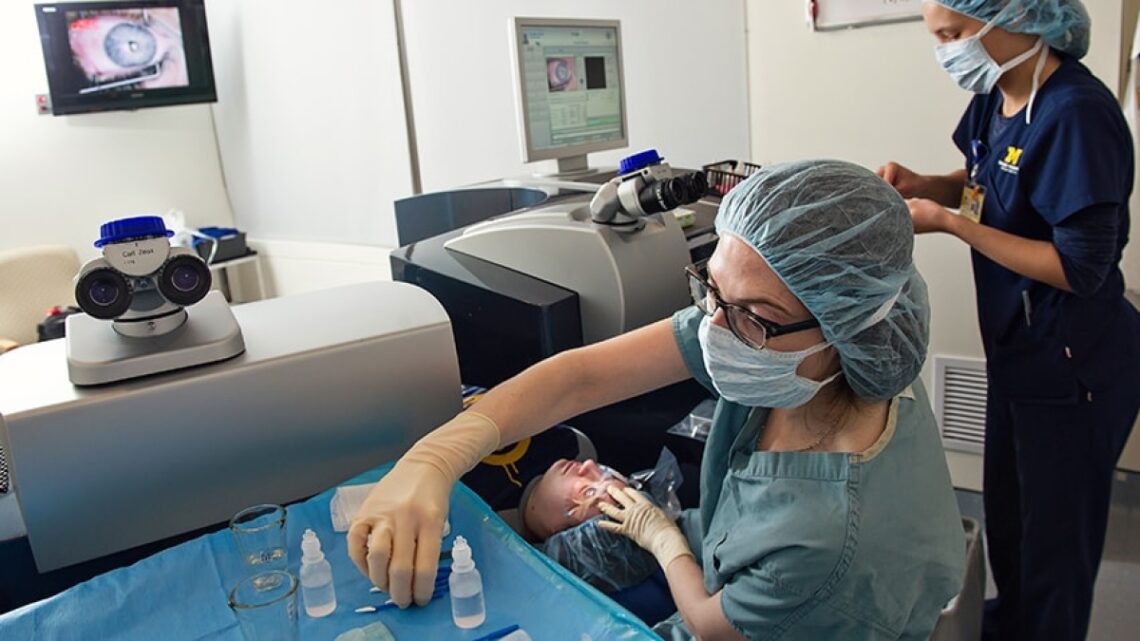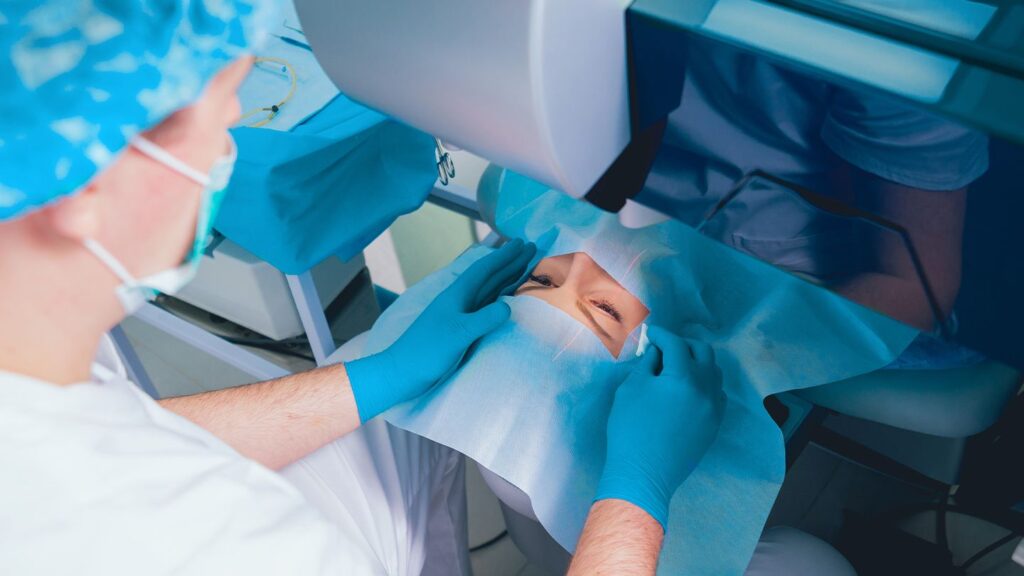
Precision and Clarity: Navigating the World of LASIK Vision Correction
LASIK vision correction has revolutionized the way we see the world. With its ability to correct refractive errors such as nearsightedness, farsightedness, and astigmatism, LASIK has become a popular choice for those seeking to improve their visual acuity. Understanding the science behind LASIK and what to expect during the procedure can provide clarity and peace of mind for those considering this life-changing surgery.
Understanding LASIK Vision Correction
LASIK, which stands for Laser-Assisted In Situ Keratomileusis, is a surgical procedure that reshapes the cornea to correct vision problems. The cornea, the clear outer layer of the eye, plays a crucial role in focusing light onto the retina, allowing us to see clearly. By altering the shape of the cornea, LASIK surgery can correct refractive errors and improve visual acuity.
Imagine a world where you wake up every morning with crystal-clear vision, no longer needing to fumble for your glasses or put in contact lenses. LASIK has made this dream a reality for millions of people around the globe. Let’s delve deeper into the science behind this remarkable procedure.
The Science Behind LASIK
LASIK operates on the principle of reshaping the cornea to redirect light rays onto the retina in a way that compensates for the individual’s refractive error. This is achieved by creating a small flap in the cornea and using an excimer laser to remove precise amounts of tissue from the underlying corneal layers. The excimer laser, known for its precision and accuracy, emits a cool ultraviolet light beam that breaks the molecular bonds in the cornea, allowing the surgeon to sculpt it with incredible precision.

During the procedure, the surgeon carefully calculates the amount of tissue to be removed based on the patient’s unique refractive error. This personalized approach ensures that the cornea is reshaped to perfection, resulting in improved vision. The excimer laser’s ability to remove tissue in microscopic increments allows for precise adjustments, ensuring optimal outcomes for patients.
The Procedure: What to Expect
Prior to the surgery, patients undergo a thorough consultation to determine their eligibility for LASIK. Factors such as corneal thickness, overall eye health, and stability of the refractive error are assessed. This comprehensive evaluation ensures that only suitable candidates undergo the procedure, maximizing the chances of success.
Once cleared for the procedure, patients are given pre-surgical instructions to follow, including ceasing the use of contact lenses and avoiding certain medications. These precautions are taken to ensure that the cornea is in its natural state and that the surgery can be performed without any complications.
The actual LASIK procedure itself is relatively quick, usually taking less than 30 minutes to complete. Local anesthesia in the form of eye drops is used to numb the eye, ensuring a painless experience. While some patients may experience slight pressure or discomfort during the procedure, it is generally well-tolerated.
After the surgeon creates the corneal flap, the excimer laser is used to reshape the cornea with utmost precision. The surgeon carefully monitors the process, ensuring that the desired correction is achieved. Once the cornea is reshaped, the flap is gently repositioned, acting as a natural bandage that promotes faster healing.
Following the procedure, patients are advised to rest and avoid any strenuous activities for a few days. This allows the cornea to heal and stabilize. The healing process is rapid, with many patients experiencing improved vision within 24 to 48 hours. However, it is important to note that individual healing times may vary.
It is worth mentioning that LASIK has evolved significantly over the years, with advancements in technology and surgical techniques. Today, LASIK is a highly refined procedure that offers exceptional results and a high level of patient satisfaction. The combination of skilled surgeons, state-of-the-art equipment, and thorough pre-operative evaluations has made LASIK one of the most popular elective surgeries worldwide.
In conclusion, LASIK is a revolutionary procedure that has transformed the lives of countless individuals by providing them with clear and crisp vision. The science behind LASIK, coupled with the meticulous surgical technique, ensures that patients can achieve their desired visual outcomes. If you are considering LASIK, consult with a qualified ophthalmologist who can guide you through the process and determine if you are a suitable candidate. Embrace the freedom of clear vision and bid farewell to the hassles of glasses and contact lenses!
The Benefits of LASIK Vision Correction
LASIK offers numerous benefits that go beyond improved visual acuity. For individuals who have relied on glasses or contact lenses for years, LASIK provides the freedom to wake up and see clearly without the need for corrective eyewear.
Imagine waking up in the morning and being able to see the world around you with crystal clarity. No more fumbling for your glasses or searching for your contact lenses. With LASIK vision correction, this can become a reality.
One of the primary benefits of LASIK is significantly improved visual acuity. Many patients achieve 20/20 vision or better, allowing them to see details and objects with remarkable clarity. This newfound visual acuity can enhance various aspects of daily life, from reading small print to enjoying outdoor activities without the hindrance of glasses or contact lenses.

Imagine being able to read a book without squinting or straining your eyes. LASIK can make this possible. By reshaping the cornea, LASIK corrects refractive errors such as nearsightedness, farsightedness, and astigmatism, resulting in improved visual acuity.
Beyond the immediate improvement in vision, LASIK can also lead to positive lifestyle changes. Eliminating the need for glasses and contact lenses can offer newfound convenience and freedom. Activities such as swimming, exercising, or even just stepping outside on a rainy day are no longer potential obstacles for those who have undergone LASIK. Get more positive lifestyle changes at https://www.apa.org/topics/behavioral-health/healthy-lifestyle-changes.
Imagine being able to go for a swim without worrying about your contact lenses getting lost or your glasses getting wet. LASIK can make this possible. With LASIK, you can enjoy the freedom of participating in various activities without the constant worry of your vision being compromised.
Furthermore, LASIK can also have a positive impact on your self-confidence. Many individuals who have relied on glasses or contact lenses for years may feel self-conscious about their appearance. LASIK can help boost self-esteem by eliminating the need for these corrective eyewear options.
Imagine being able to walk into a room without feeling the need to hide behind your glasses. LASIK can make this possible. By providing clear vision without the need for glasses or contact lenses, LASIK can help individuals feel more confident and comfortable in their own skin.
In conclusion, LASIK offers not only improved visual acuity but also a range of lifestyle benefits. From the convenience of waking up with clear vision to the freedom of participating in various activities without the hindrance of glasses or contact lenses, LASIK can truly transform lives. So why wait? Consider LASIK vision correction and experience the numerous benefits it has to offer.
Evaluating the Risks and Complications
While LASIK is generally a safe and effective procedure, it is important to understand the potential risks and complications associated with it. By being fully informed, patients can make an educated decision regarding their vision correction options.
One of the potential risks of LASIK is the development of dry eyes. This occurs when the eyes do not produce enough tears to keep them lubricated. While this side effect is usually temporary and improves as the eyes heal, it can cause discomfort and blurry vision in the meantime. It is important for patients to discuss this possibility with their LASIK surgeon and follow any recommended post-operative care instructions to minimize the risk of dry eyes.
Another common side effect of LASIK is glare and halos around lights, especially at night. This can make it difficult to drive or perform tasks in low-light conditions. While these visual disturbances usually improve over time, it is important for patients to be aware of this potential side effect and discuss it with their surgeon. In some cases, additional treatments or adjustments may be necessary to reduce glare and halos.
Temporary discomfort is also a common side effect of LASIK. After the procedure, patients may experience a gritty or foreign body sensation in their eyes, as well as mild pain or burning. These symptoms typically subside within a few days or weeks as the eyes heal. It is important for patients to follow their surgeon’s instructions for pain management and report any severe or prolonged discomfort.
Potential Side Effects
Some of the common side effects of LASIK include dry eyes, glare, halos, and temporary discomfort. These side effects are typically temporary and subside within a few weeks as the eyes heal. However, it is crucial to discuss these potential side effects with a qualified LASIK surgeon to determine the best course of action.
In addition to the temporary side effects mentioned above, there are also rare but more serious complications that can occur with LASIK. These include infection, corneal flap complications, and vision loss. While these complications are extremely rare, it is important for patients to be aware of them and discuss them with their surgeon. By choosing an experienced and reputable surgeon, the risk of these complications can be minimized.
Long-term Implications
While the majority of LASIK patients experience long-term success with improved vision, it’s important to note that individual results may vary. Factors such as age, pre-existing eye conditions, and the stability of the refractive error can influence long-term outcomes. Regular follow-up visits with an eye care professional can help address any concerns and ensure ongoing eye health.
Age is an important factor to consider when evaluating the long-term implications of LASIK. While LASIK can be performed on individuals of various ages, the stability of the refractive error plays a significant role in determining the success of the procedure. Younger patients whose vision is still changing may not be suitable candidates for LASIK as their refractive error may continue to progress after the surgery. On the other hand, older patients who have a stable refractive error are more likely to achieve long-term success with LASIK.
Pre-existing eye conditions can also affect the long-term outcomes of LASIK. Patients with conditions such as glaucoma, cataracts, or corneal diseases may not be suitable candidates for LASIK or may require additional treatments or precautions. It is important for patients to disclose any pre-existing eye conditions to their surgeon during the consultation process to ensure that LASIK is the appropriate option for them.
Regular follow-up visits with an eye care professional are essential for monitoring the long-term health of the eyes after LASIK. These visits allow the surgeon to assess the stability of the refractive error, check for any signs of complications or changes in vision, and provide necessary treatments or adjustments if needed. By maintaining a proactive approach to eye care, patients can ensure the best possible long-term outcomes after LASIK.
Preparing for LASIK Surgery
Preparing for LASIK surgery involves several important steps to ensure a smooth and successful procedure. Being proactive in the preparation process can contribute to a positive outcome and maximize the chances of achieving optimal vision correction.
Pre-Surgery Consultation
The first step in preparing for LASIK is scheduling a consultation with a qualified ophthalmologist or LASIK surgeon. During this consultation, the surgeon will evaluate the patient’s current eye health, determine their eligibility for LASIK, and address any concerns or questions.
Steps to Take Before Surgery
Leading up to the surgery, patients will receive specific instructions from their surgeon. These instructions may involve temporarily discontinuing the use of contact lenses, avoiding certain medications that can interfere with the healing process, and arranging for transportation to and from the surgical facility on the day of the procedure.
Life After LASIK: What to Expect
After LASIK surgery, the road to optimal vision involves post-surgery care and an adjustment period as the eyes adapt to the newly corrected vision. Understanding what to expect during this time can help ease any concerns and ensure a successful transition into life after LASIK.
Post-Surgery Care
Following LASIK, patients will be given specific post-operative care instructions to promote healing and minimize any potential complications. These instructions may include using prescribed eye drops, avoiding activities that can strain the eyes, and attending follow-up appointments to monitor progress.
Adjusting to New Vision
It is important to note that adjusting to new vision can take time. While some patients experience immediate improvement, others may have a short adjustment period. During this time, it is normal to experience fluctuations in vision, dryness, or temporary discomfort. However, as the eyes continue to heal, vision typically stabilizes and becomes clear and consistent.
In Conclusion
LASIK vision correction offers a precise and effective solution for those seeking to improve their visual acuity. By understanding the science behind LASIK, evaluating the risks and benefits, and properly preparing for the procedure, patients can navigate the world of LASIK with precision and clarity. With post-surgery care and patience during the adjustment period, the path to enhanced vision and a life with greater visual freedom awaits.
Other Article: How Sleep Apnea Machines Improve Daily Performance and Energy Levels


